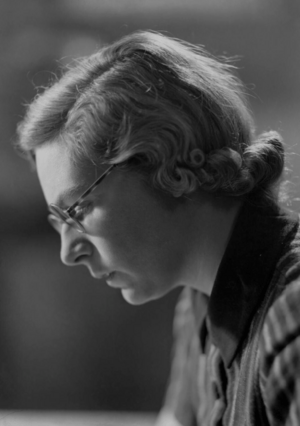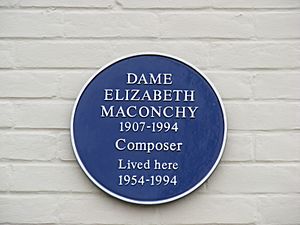Elizabeth Maconchy facts for kids
Quick facts for kids
Elizabeth Maconchy
|
|
|---|---|

in 1938 by Howard Coster
|
|
| Born |
Elizabeth Violet Maconchy
19 March 1907 Broxbourne
|
| Died | 11 November 1994 |
| Nationality | United Kingdom |
| Education | Royal College of Music |
| Occupation | composer |
| Spouse(s) | William LeFanu |
| Children | two |
Dame Elizabeth Violet Maconchy LeFanu DBE ( 19 March 1907 – 11 November 1994) was an Irish-English composer. Maconchy is considered to be "one of the finest composers the British Isles have produced"
Contents
Biography
Elizabeth Violet Maconchy was born in Broxbourne, Hertfordshire, of Irish parents, and grew up in England and Ireland. Her family moved to Ireland in 1917, where they lived in Howth, on the east coast. The adolescent Maconchy began her musical studies in Dublin, studying piano with Edith Boxhill, and harmony and counterpoint with Dr John Larchet. Those formative years in Ireland were important for Maconchy, who considered herself Irish. Throughout her career she was identified as an Irish composer, or as an English composer with 'Celtic' influences, by reviewers and commentators.
In 1923, at the age of sixteen, she moved to London to enrol at the Royal College of Music. At the RCM Maconchy studied under Charles Wood and Ralph Vaughan Williams. Her contemporaries at the college included Grace Williams, Dorothy Gow, and Ina Boyle. Early compositions such as the violin sonata and Piano Concertino of 1927 already show the influence of European composers, especially Bartok. As a student, Maconchy was awarded the Blumenthal Scholarship in 1927, and the Octavia Scholarship of 1930, which allowed her to continue her studies in Prague. Her first public recognition came in 19 March 1930 with a performance of her Piano Concerto, conducted by her teacher there, Karel Jirak. This was followed on 30 August by a BBC Proms performance of her cantata The Land, conducted by Henry Wood, which was inspired by the long poem of the same name by Vita Sackville-West.
In response to the scarce opportunities for young avant garde composers and for female composers, a group of women got together to organise regular concerts at the small Ballet Club theatre in Notting Hill, London, showcasing new work. It has been claimed that this venture "changed the face of music in London", and that it "prove[d] a lifeline for Elizabeth Maconchy through the 1930s".
In 1930 Maconchy married William LeFanu, with whom she had two daughters: Elizabeth Anna LeFanu (born 1939) and Nicola LeFanu (born 1947). In 1932, Maconchy developed tuberculosis and she moved with her family from London to Kent. She returned to Ireland in 1939, living in Dublin for a brief period, during which she composed her Fifth String Quartet, which some critics consider her greatest achievement, and gave birth to a daughter.
Maconchy did much to improve the conditions of composers, being elected Chair of the Composers Guild of Great Britain in 1959, a position she held for a number of years. She was also President of the Society for the Promotion of New Music. Maconchy was a socialist, and her activism extended to supporting the Democratic/Republican side in the Spanish Civil War, and other causes.
Maconchy's friends included the English composer Elisabeth Lutyens, the Welsh composer Grace Williams, the Irish composer Ina Boyle, and the Czech music critic Jan Löwenbach.
Maconchy once declared that: "for me, the best music is an impassioned argument".
She died in Norwich, England.
Compositions
Maconchy is considered to be "one of the finest composers the British Isles have produced". Her work has been compared to that of Bartok, who was an acknowledged influence, and also to Beethoven and Mozart, as well as (favourably) to contemporaries such as Britten. She produced over 200 works. According to Ailie Bloony, Maconchy was "a gestural composer, concerning herself with short musical fragments, as opposed to large-scale concepts or templates", at least in part because of her "ideology" as a composer, so that "she never planned anything out, musically speaking, in any great detail in advance of composition, [and by using shorter formats] she could afford to explore the possibilities implicit in the ideas themselves as they arose". In terms of style, Maconchy had "a predilection for intervallic composition", and, "profoundly influenced by the resonances produced by certain intervals, [she] tended to build works around one or a small number of intervals, which varied according to the work in question". A favoured "harmonic device" was the "simultaneous use of major and minor sonorities", which "came to denote episodes of heightened emotion". It has been argued that her work is often "driven by rhythm", which gives it its characteristic confluence of "energy, dynamism and imagination".
Maconchy's cycle of thirteen string quartets, composed between 1932 and 1983, is regarded as the peak of her musical achievements. Historian of music Anna Beer has contended that "Maconchy loved the quartet form because it represented a debate, a dialectic between four balanced, individual, impassioned voices."
She also wrote for voice. In 1943 she responded to war with "The Voice of the City", for women's chorus, about the Battle of Stalingrad. In 1981 she set to music prose versions of some Petrarchan sonnets, by the Irish writer J.M. Synge, under the title 'My Dark Heart'.
String quartets
- String Quartet No. 1 (1932/33)
- String Quartet No. 2 (1936)
- String Quartet No. 3 (1938)
- String Quartet No. 4 (1942/43)
- String Quartet No. 5 (1948)
- String Quartet No. 6 (1950)
- String Quartet No. 7 (1955)
- String Quartet No. 8 (1967)
- String Quartet No. 9 (1968)
- String Quartet No. 10 (1972)
- String Quartet No. 11 (1976)
- String Quartet No. 12 (1979)
- String Quartet No. 13 Quartetto Corto (1982–83)
Symphonic works
- Suite in E minor for string orchestra (1924)
- Fantasy for flute, harp and string orchestra (1926, lost)
- Elegy for flute, horn and string orchestra (1926, lost)
- Fantasy for Children for small orchestra (1927–28)
- Theme and Variations for orchestra (1928)
- The Land, symphonic suite after V. Sackville-West's poem, for orchestra (1929)
- Symphony (No. 1), for orchestra (1929–30, withdrawn)
- Suite for chamber orchestra (1930, withdrawn)
- Comedy Overture for orchestra (1932–33)
- Two Dances from the ballet Puck Fair, for orchestra (1940)
- Variations on a Well-Known Theme, for orchestra (1942)
- Theme and Variations for string orchestra (1942–43)
- Suite from the ballet Puck Fair, for orchestra (1943)
- Symphony (No. 2), for orchestra (1945–48, withdrawn)
- Nocturne for orchestra (1950–51)
- Proud Thames : Coronation Overture, for orchestra (1952–53)
- Symphony for double string orchestra (1952–53)
- Suite on Irish Airs, for small orchestra (1953 ; arr. for full orch, 1954)
- Suite on Irish Airs, version for full orchestra (1955)
- A Country Town, 6 short pieces for orchestra (c. 1956) [arr. of piano pieces from 1939]
- Music for Woodwinds and Brass (1965–66)
- An Essex Overture, for orchestra (1966)
- Three Cloudscapes for orchestra (1968, withdrawn)
- Genesis for chamber orchestra (1972–73)
- Sinfonietta, for orchestra (1976)
- Little Symphony, for orchestra (1980–81)
- Music for Strings (1981–82)
- Life Story, for string orchestra (1985)
Concertante works
- Andante and Allegro, for flute and string orchestra (1926–27)
- Concertino (No. 1) for piano and chamber orchestra (1928 ; rev. 1929–30)
- Viola Concerto (1937, withdrawn)
- Dialogue for piano and orchestra (1940–41)
- Concertino (No. 1) for clarinet and string orchestra (1945)
- Concertino (No. 2) for piano and string orchestra (1949)
- Concertino for bassoon and string orchestra (1950)
- Toombeola, for violin and string orchestra (1954, withdrawn)
- Concerto for oboe, bassoon and string orchestra (1955–56)
- Suite for oboe and string orchestra (1955–56)
- Serenata concertante for violin and orchestra (1962)
- Variazioni concertante, for oboe, clarinet, basson, horn and string orchestra (1964–65)
- Epyllion, for solo cello and 15 strings (1973–75)
- Romanza for viola, woodwind quintet and string quintet (1979)
- Tribute, for violin and woodwind octet (1982)
- Concertino (No. 2) for clarinet and small orchestra (1984)
Stage
- Great Agrippa, ballet (1933)
- Puck Fair, ballet, libretto: F. R. Higgins, (1939–40)
- The Sofa, comic opera, libretto: Ursula Vaughan Williams, (1956–57)
- The Three Strangers, opera, libretto: Elizabeth Maconchy after Thomas Hardy, (1957–58, rev. 1967, −69, −77)
- The Departure, opera, libretto: Anne Ridler, (1960–61, rev. 1977)
- The Birds, extravaganza, Elizabeth Maconchy after Aristophanes, (1967–68)
- Johnny and the Mohawks, children's opera (1969)
- The Jesse Tree, masque, libretto: Anne Ridler, (1969–70)
- The King of the Golden River, children's opera, libretto: Elizabeth Maconchy after John Ruskin (1975)
Honours
In 1933, Maconchy's quintet for oboe and strings won The Daily Telegraph Chamber Music Competition, and was recorded by Helen Gaskel with the Griller Quartet soon afterwards on HMV Records. In 1948, she was awarded the Edwin Evans Prize for her String Quartet No. 5. In 1953, her "Proud Thames" overture won the London County Council Competition as Coronation Overture for the new Queen of the United Kingdom.
In 1959, Maconchy was invited to chair the Composers' Guild of Great Britain, the first woman to do so. In 1960, she was awarded the Cobbett Medal for chamber music. She was made a Commander of the Order of the British Empire (CBE) in 1977, and elevated to Dame Commander (DBE) in 1987.
See also
 In Spanish: Elizabeth Maconchy para niños
In Spanish: Elizabeth Maconchy para niños


